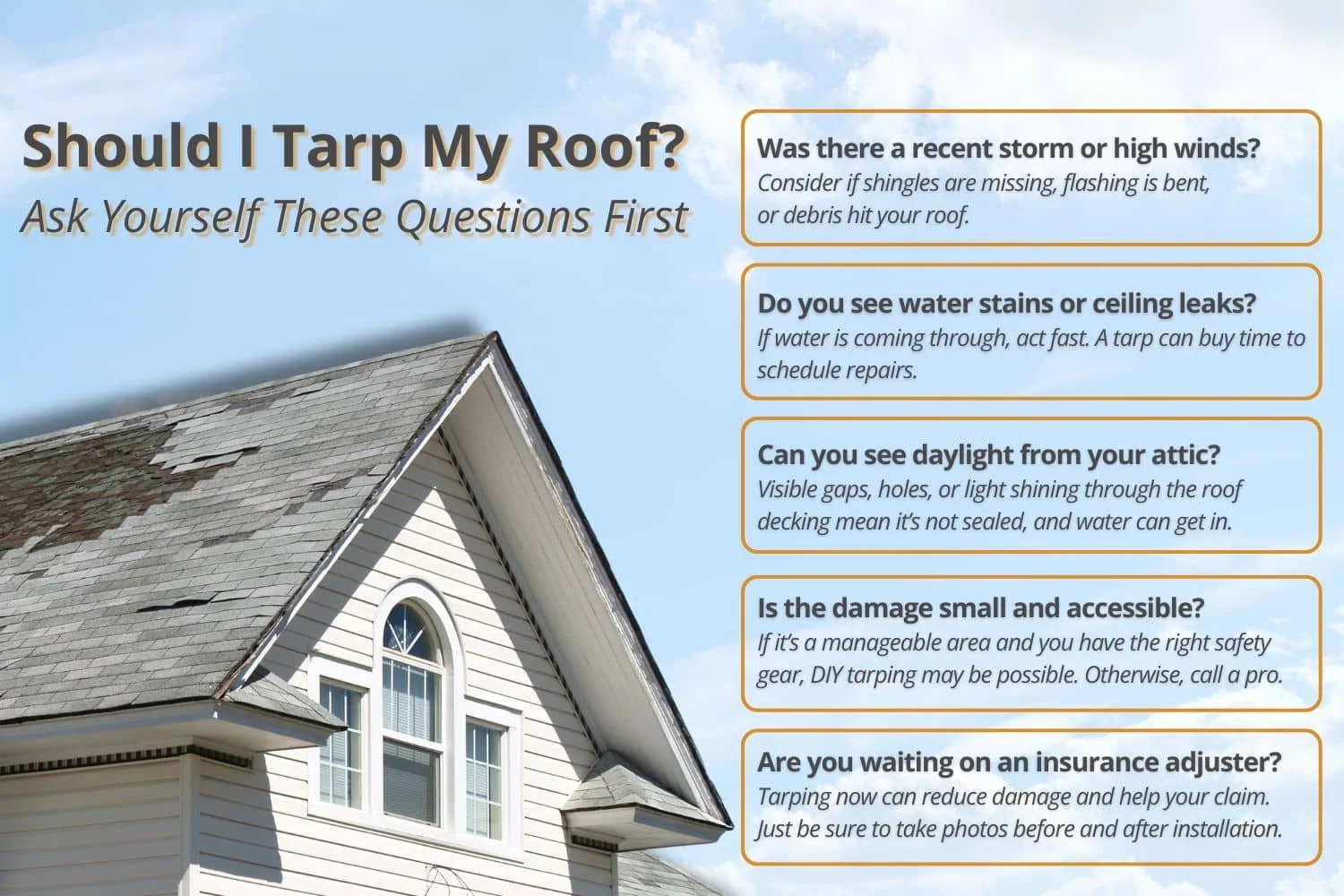How to Tarp a Roof the Right Way (and When It Matters)
Roof damage can happen fast, especially after a storm. Whether it’s from high winds, fallen branches, or flying debris, even a small hole can lead to serious water damage.
Tarping your roof is one way to prevent further issues while you wait for repairs. But it has to be done correctly. An improperly installed tarp can blow off, cause more damage, or even void your insurance claim.
In this guide, we’ll explain when it makes sense to tarp a roof, how to do it safely, and why getting a professional opinion could save you thousands in the long run.
When Should You Tarp a Roof?
Tarping is a temporary fix. It’s not meant to replace real repairs, but it does protect your home while you line up a roofing contractor or inspection.
Here are a few situations where a tarp can help:
After a hurricane or thunderstorm
If shingles are missing or damaged
If you see daylight or water coming through your ceiling
While waiting for an insurance adjuster or contractor
To prevent mold or interior water damage
According to the National Storm Damage Center, over $15 billion in property damage happens annually due to wind and hail. Fast action, like tarping, helps limit the loss.
How to Tarp a Roof in 6 Steps
1. Assess the Damage Safely
Before anything, make sure the area is safe. Do not climb on the roof during rain, wind, or if it looks unstable. If you can, view the damage from the ground or attic. If not, wait for a professional.
2. Gather Supplies
You’ll need:
A heavy-duty tarp (ideally 6 mil or thicker, waterproof, and UV-resistant)
Roofing nails or screws with washers
2x4 wooden boards (to secure the tarp edges)
A hammer or cordless drill
Safety gear: gloves, boots with good traction, and a harness if you’re working at height
3. Cover the Damaged Area with Extra Room
The tarp should extend at least 3 feet beyond the damaged area in all directions. If the spot is near the edge, cover from the ridge downward to ensure proper water runoff.
4. Anchor the Tarp at the Top First
Nail or screw a 2x4 board across the top edge of the tarp to keep it from lifting. This board should sandwich the tarp to the roof decking. Avoid attaching anything directly to shingles unless necessary.
5. Secure the Sides and Bottom
Repeat the same board-and-screw setup on the sides and bottom edges. Pull the tarp tight as you go to prevent water pooling or wind uplift.
6. Check for Gaps and Pooling
Once the tarp is secured, walk around the property and check from multiple angles. Watch for flapping, sagging, or open edges. Make sure the tarp directs water off the roof and into your gutters or yard. Water should not flow into the walls or pool near the foundation.
How Long Can a Tarp Stay on a Roof?
Most roof tarps are designed to last 30 to 90 days. After that, exposure to sun, rain, and wind can break down the material.
Some insurance companies require repairs within a specific time window, so don’t rely on a tarp as a long-term fix. Always check your policy to stay compliant.
Common Tarping Mistakes to Avoid
Using tarps that are too thin or not rated for outdoor use
Failing to anchor edges properly
Waiting too long after a storm to take action
Walking on a roof that’s wet or unstable
Nailing directly into water-damaged areas without sealing afterward
If the damage is severe or hard to access, it’s safest to skip the DIY and call in a licensed roofer or inspector.
Other Related Questions About Roof Damage and Repairs
Does a roof leak always mean I need a new roof?
Not necessarily. Many leaks come from flashing issues, damaged shingles, or worn-out seals around vents or chimneys. A home inspection can help pinpoint the exact cause so you’re not replacing more than you need to.
Will a four-point inspection catch roof problems like these?
Yes. A four-point inspection includes the roof’s visible condition. Inspectors look for signs of leaks, damage, and age that could affect your home’s insurability or resale value. Learn what else a four-point inspection covers.
How do I know if roof water damage has reached my ceiling or walls?
Look for musty smells, sagging drywall, or dark stains on ceilings. Water often travels beyond the point of entry, so even a small roof issue can lead to bigger problems indoors. A moisture meter or inspection can confirm the extent of damage.
How do I know if water got into my attic or walls?
Check for damp insulation, musty smells, or ceiling stains. These are signs that water has already entered. A moisture meter or inspection can confirm how deep the damage goes.
When to Call a Professional
Roof tarping can be dangerous, especially on steep slopes, wet surfaces, or multi-story homes. It’s also hard to tell from the outside just how deep the damage goes.
You should call in a professional if:
You’re dealing with large or multiple leaks
You don’t have safe access to the roof
You need insurance documentation
You want to know whether the structure underneath is still sound
A licensed home inspector or roofer can evaluate the damage, safely install a tarp, and help guide your next steps.
Conclusion
Tarping your roof the right way can buy you time, reduce damage, and make the repair process smoother. But it has to be done carefully and quickly.
If you're unsure how to move forward after roof damage or you need to book an inspection before buying or selling a home, the Taylor Made team is here for you.


